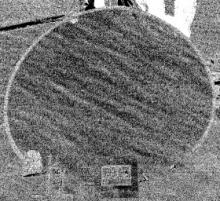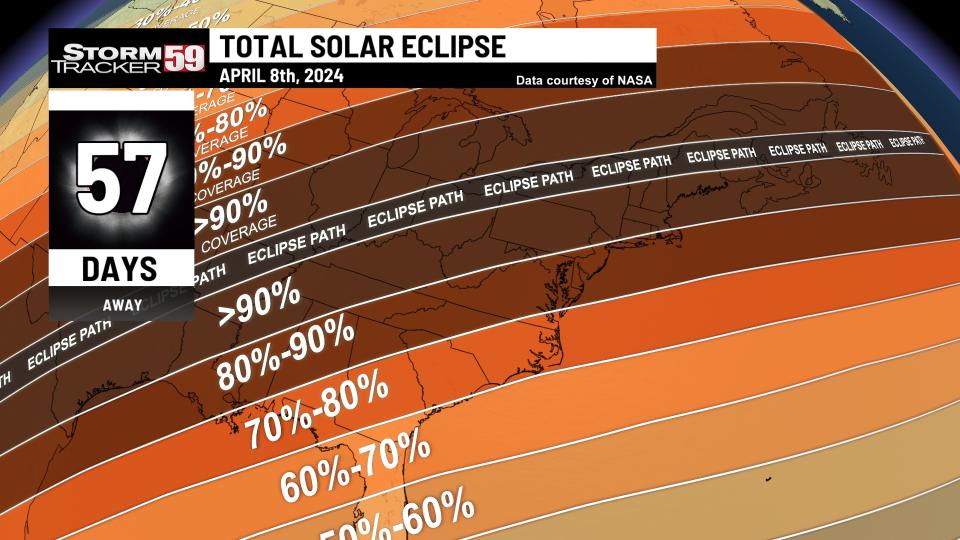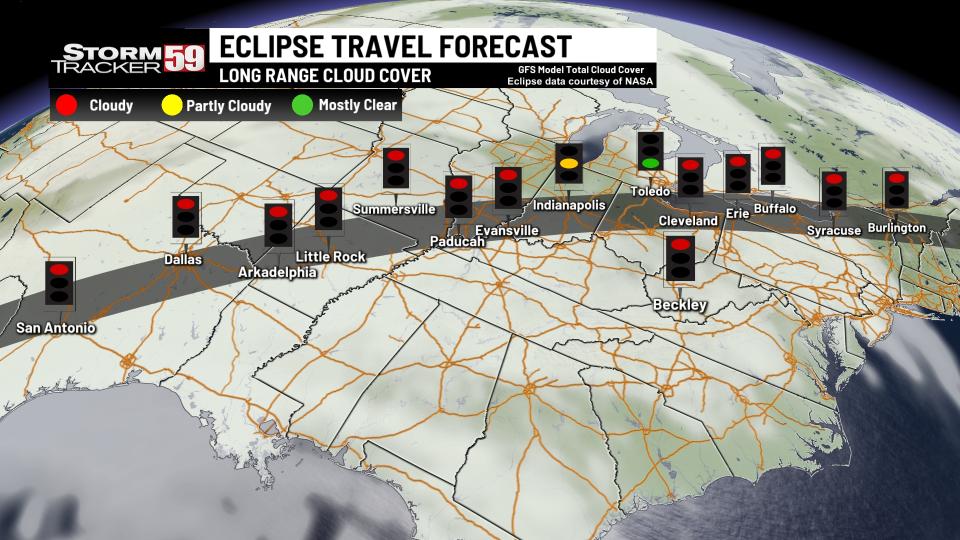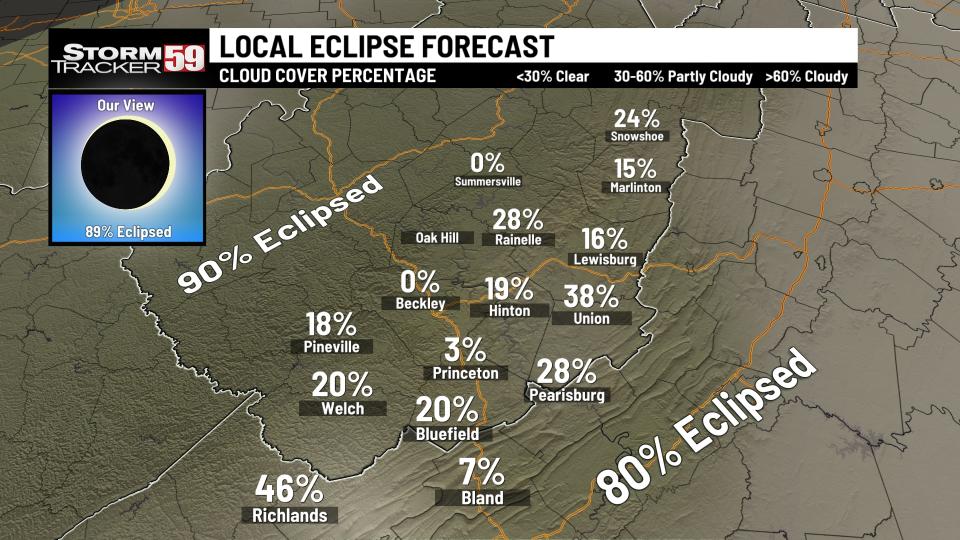WATCH: StormTracker 59 April Total Solar Eclipse Stream
59News Total Eclipse Live Stream
NEW YORK (WVNS) — StormTracker 59 Meteorologist Bradley Wells will be on location in the path of totality with a live stream from Lewis County, New York. Available for free on our social pages, website, and app. Beginning at 2:30pm, we’ll live stream the event through totality for all to enjoy. Totality is expected at 3:26pm in New York.
A live stream of totality will play in this story as it is happening!

The April 8th, 2024 Total Solar Eclipse has been on the minds of many since the last total solar eclipse to cross the U.S. in 2017. The annular solar eclipse in August 2023 spurred excitement for this Monday’s eclipse too.

With so many eclipses in just the last 10 years, what makes the Total Solar Eclipse on April, 8th so special? It’ll be the the last one in the lower 48 states until 2044 and even then, it’ll only be Eastern Montana that sees it right before sunset August 23rd, 2044.
Total Solar Eclipse Facts
The April 2024 Eclipse will travel from Texas through Maine during the middle of the afternoon providing millions with a great opportunity to see a celestial event some call enlightening. According to the Great American Eclipse website, over 31 million Americans live in the path of totality. NASA maps of the 2024 eclipse show the entire United States will see a partial solar eclipse on Monday.
While the sun is 400 times larger than the moon, it is 400 times farther away from the earth. When the moon moves in front of the sun, it casts a narrow shadow on the Earth’s surface. To truly experience a solar eclipse, a trip to totality, or this narrow shadow, is needed. During totality the moon completely blocks the sun allowing for the normally hidden sun’s corona to shine brightly against a darkened sky.

During a total solar eclipse, while in the path of totality, several stages happen leading up to totality. Totality is the 1-4 minutes where the moon completely blocks the sun before moving on.
First Contact
When the moon first touches the sun, it’s called first contact. From here the moon continues to move across the sun in a partial eclipse. Specialized eclipse glasses are required to view safely.
Shadow Bands
Leading up to and shortly after totality, when the moon covers the entire surface of the sun, long, wavy, fast moving dark bands separated by white spaces can be seen on the ground and buildings. While faint and difficult to photograph, these are caused by sun rays passing through mountains and valleys on the moon then distorted by our atmosphere. Similar to how starlight is affected by the air around our planet. Using a large white piece of paper or poster paper will highlight this phenomenon.

Diamond Ring
Moments before the moon completely covers the sun, a sliver of sunlight beams brightly at the top of an eclipsed ring below. Even with 1% of the sunlight coming through, eclipse glasses will still be needed.

Since the moon and sun aren’t perfect spheres, sunlight finds it’s way through valleys and craters along the moons edge. These are very short lived and aren’t always noticeable during an eclipse but the glittering effect can be fun to watch for.
The main event of a total solar eclipse, is the 1-4 minutes the moon completely covers the sun, or second contact. At this point, eclipse glasses can be taken off to view the stunning darkened sun with its corona reaching out from behind the moon.
BE VIGILANT, eclipse glasses will be needed once the moon begins to move away. The length of totality depends on where are you are lasting a little as just a minute or two up to 4 minutes.
During totality, a pink hue may be seen hugging the lunar surface known as the chromosphere or inner atmosphere of the sun. The corona, or outer atmosphere, can be visible streaming out into space. Normally both a blocked by the blinding light we see during the day.Those in totality will see a 360 “sunset” sky. Normally when the sun set, the sky is brightly colored in the west while darker towards the east as night falls. In totality, the shadow cast by the moon keep the entire horizon evenly lit, in sunset color, in all directions.
Travel to Totality Forecast
For those traveling to totality, cloud forecasts will be very important since a nice, clear sunny day is best for the short lived 2-4 minutes the moon completely blocks the sun. Our StormTracker 59 team has just the forecast for folks looking to head out.
What We’ll See
Sadly, our region is several hundred miles away from the path of totality but we’ll still know the eclipse is happening. A partial solar eclipse can be just a fun to watch but will require special eye protection by using solar eclipse glasses or welders glass rated above shade #14. In most counties, we’ll see a 80-90% eclipsed sun, as long as the clouds hold off.

On Monday, April 8th for our region, the eclipse will begin at 1:56pm with the moon moving across the sun. At first not much difference in sunlight and those wishing to see the eclipse will need special glasses. Do not look directly at the sun, permanent damage to your eyes can happen in less than a minute. The height of the eclipse, when the sun is 89% eclipsed will occur at 3:13pm. The moon will continue to move across the sun until 4:27pm. While we won’t see total eclipse, the skies will darken and colors will be muted like taking away contrast on a camera filter.
NASA has put together an amazing tool for those traveling to totality or staying home for the eclipse. An interactive map can show you exactly what you’ll see and when from town to town.
For the latest news, weather, sports, and streaming video, head to WVNS.








